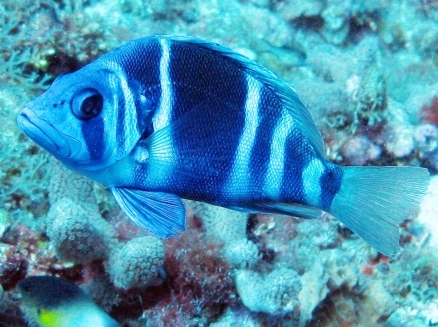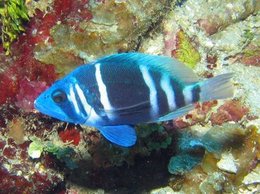Indigo hamlet (Oceans and seas)
Contents
Indigo hamlet
The indigo hamlet (scientific name: Hypoplectrus indigo) is a member of the grouper/seabass family (Family Serranidae) that live on coral reefs in the Western Atlantic Ocean and the Caribbean Sea (Caribbean Sea large marine ecosystem).
|
Scientific Classification Kingdom: Animalia (Animals) |
Physical Description
Indigo hamlets range fromseven to14 centimeters in length. Their bodies contain a number of broad indigo/blue bars separated by thinner white bars.
Distribution
This species is found in the tropical Western Atlantic in Haiti, the Bahamas (Common coral reef fishes of the Bahamas), Jamaica, Cayman Islands, Florida (USA), and continental western Caribbean Sea . They are absent in Puerto Rico, the British Virgin Islands, the United States Virgin Islands (Common coral reef fishes of the United States Virgin Islands), and the Lesser Antilles.
Habitat
Indigohamlets live on coral reefs at depths ranging from three to 45 meters.
Feeding Behavior
H.indigo is a generalistcarnivore which feeds on shrimps, crabs, mantid shrimps and small fishes.
Behavior
Indigohamlets are solitary and spend the majority of their time hunting alone in defended home ranges.
Reproduction
Reproduction in indigo hamlets takes place year round. They are simultaneous hermaphrodites, which means that they can be reproduce as males and females at the same time. Before sunset, the fish leave their home ranges to search for mates. After finding a potential mate, one of the hamlets acts as a female while the other acts as a male. They release gametes into the water column during a three second “mating clasp”. After approximately 15 minutes, the fish repeat the process but with each individual switching sex roles. Eggs are fertilized in the water column. After the eggs hatch, the larvae enter the pelagic stage until they settle back on the reef.
Conservation Status
The indigo hamlet isnot deemed to be a species at risk.
References and Further Reading
- Encyclopedia of Life. 2011.
- FishID. 2010.
- Humann, P. and N. Deloach (Editor), 1994. Reef Fish Identification: Florida, Caribbean, Bahamas. New World Publications, Inc. Jacksonville, FL. ISBN: 1878348078
- Deloach, N. 1999. Reef Fish Behavior, Florida, Caribbean, Bahamas. New World Publications, Inc. Jacksonville, FL. ISBN: 1878348280

